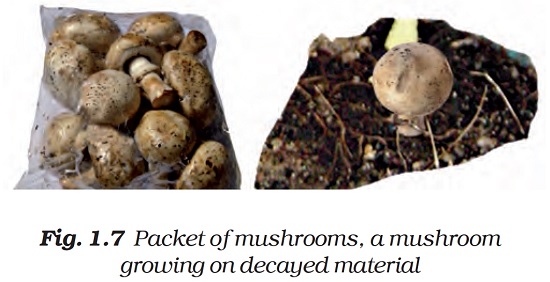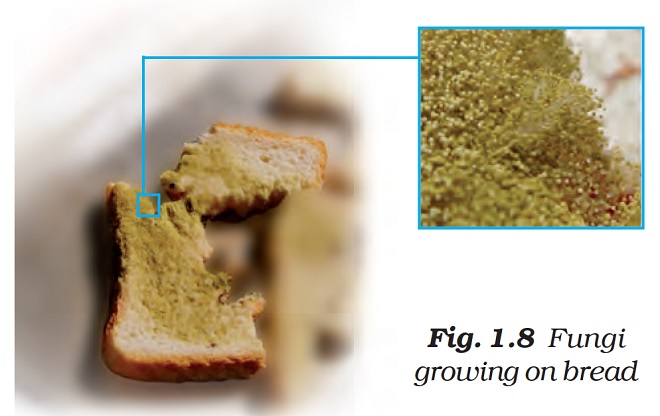1.4 SAPRO TROPHS
NCERT Class 7 Science Textbook for Blind Students made Screen readable by Professor T K Bansal.
You might have seen packets of mushrooms sold in the vegetable market. You may have also seen fluffy umbrella-like patches growing in moist soils or on rotting wood during the rainy season (Figure 1.7). Let us find out what type of nutrients they need to survive and from where they get them.
Figure 1.7 Packet of mushrooms, a mushroom growing on decayed material

Boojho wants to know how these organisms acquire nutrients. They do not have mouths like animals do. They are not like green plants as they lack chlorophyll and cannot make food by photosynthesis.
Activity 1.2
Take a piece of bread and moisten it with water. Leave it in a moist warm place for 2-3 days or until fluffy patches appear on them (Figure 1.8). What is the colour of these patches? Observe the patches under a microscope or a magnifying glass. Write down your observations in the notebook. You will see cotton-like threads spreading on the piece of bread.
Figure 1.8 Fungi growing on bread

These organisms are called fungi. They have a different mode of nutrition. They absorb the nutrients from the bread. This mode of nutrition in which organisms take in nutrients from dead and decaying matter is called saprotrophic nutrition. Such organisms with saprotrophic mode of nutrition are called saprotrophs.
Fungi also grow on pickles, leather, clothes and other articles that are left in hot and humid weather for a long time. During the rainy season they spoil many things. Ask your parents about the menace of fungi in your house.
The fungal spores are generally present in the air. When they land on wet and warm things they germinate and grow. Now, can we not figure out how we can protect our things from getting spoiled?
Paheli is keen to know whether her beautiful shoes, which she wore on special occasions were spoiled by fungi during the rainy season. She wants to know how fungi appear suddenly during the rainy season.
Boojho says once his grandfather told him that his wheat fields were spoiled by a fungus. He wants to know if fungi cause diseases also.
Paheli told him that many fungi like yeast and mushrooms are useful, but some fungi cause diseases in plants, animals including humans. Some fungi are also used as medicines.
Some organisms live together and share both shelter and nutrients. This relationship is called symbiosis. For example, certain fungi live inside the roots of plants. The plants provide nutrients to the fungus, and, in return, the fungus provides water and certain nutrients.
In organisms called lichens, a chlorophyll-containing partner, which is an alga, and a fungus live together. The fungus provides shelter, water and minerals to the alga and, in return, the alga prepares and provides food to the fungus.
